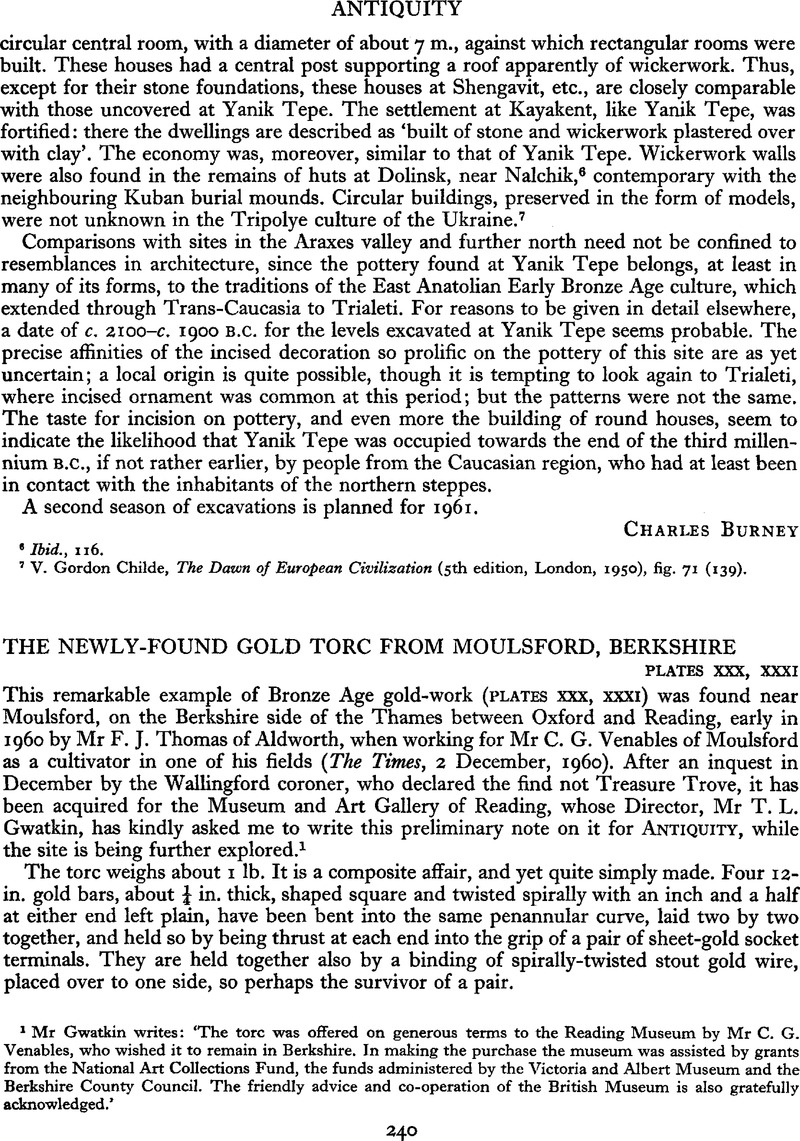Published online by Cambridge University Press: 02 January 2015

1 Mr Gwatkin writes: ‘The tore was offered on generous terms to the Reading Museum by Mr C. G. Venables, who wished it to remain in Berkshire. In making the purchase the museum was assisted by grants from the National Art Collections Fund, the funds administered by the Victoria and Albert Museum and the Berkshire County Council. The friendly advice and co-operation of the British Museum is also gratefully acknowledged.’
2 Eckes, Germania, XXII (1938), 7–11 ; Powell, Proc. Prehist. Soc., XIX (1953), 175; Torbrugge, Die Bronzezeit in der Oberpfalz (1959), 210 Taf. 74–5 (no. 347), and 40 Ber. Röm.-Germ. Komm. 1959 (1960), 53–4, 76 (no. 141). Gold in this bar form was of course meltable for other uses (Eckes, 11) ; yet Piggott, in Proc. Prehist. Soc., IV (1938), 95, rightly here noted the start of its supervening on the earlier work confined to thin wire and sheet, though the Regensburg piece would be surprising if Irish work already so early.
3 Margaret Smith, Proc. Prehist. Soc., XXV (1959), 149, and now e.g. Torbrugge, op. cit. 38–4, Abb. 11, 2 (his Phase C 1, which = Reinecke’s late B, Holste’s B2; chart, 14).
4 Nancy Sandars, Bronze Age Cultures in France (1957), 89–100, 103–4.
5 M. Smith, ibid, and 153; plain and hook-ended tores, Kersten, Zur ält. Nord. Bronzezeit (1936), 36–8; Broholm, Danmarks Bronzealder, I (1943), plain in graves 1730, 1896, 2364, hooked elsewhere; both start within Montelius II but are most typical in III (c. 1250–1050 B.C.).
6 M. Smith, op. cit., 144–64; plain-ended bronze tore, Hollingbury Hill hoard, Brighton, Sussex (B.M.), figured Arch. Journ., V (1848), 324–5; date of this whole ‘ornament-horizon’ phase, or Middle Bronze 2, c. 1200–1000 B.C., or 1250–1050.
7 In bronze best represented by the Bishopsland hoard, Co. Kildare: ÓRíordáin, Proc. Prehist. Soc., XII (1946), 161, pl. XIII; Hodges, Ulster Journ. of Arch., XIX (1956), 32–3; dating, M. Smith, op. cit., 150–1.
8 Armstrong, Cat. Irish Gold Ornaments (Dublin 1920), nos. 82–3 (pl. xiii, 105, 110), with plain penannular bracelet, 264 (pl. xviii, 376: Middle Bronze Age form, unexpanded ends) and two penannular grooved bands, on which see below with note 18.
9 Ibid., no. 81 (pl. xiii, 99).
10 Ibid., no. 80 (pl. xiii, 103), with small thick band and three penannular bracelets, one plain with unexpanded, one with slightly expanded ends and one with the same and body partly twisted: 456, 266, 253, 252 (pl. xiv, 240; pl. xviii, 386, 357, 395); theoretically, slightly expanded ends should be slightly later than unexpanded, but this is still essentially a Middle Bronze Age hoard.
11 Arch. Cant., IX (1874), 12, pl. A; Jessup, Arch, of Kent (1930), 113 and pl. X.
12 As in the freak bronze Halskragen from Katerbow, Kr. Ruppin, N. Germany: Sprockhoff, Jüngbronz. Hortfunde Periode V (1956), 234–5, Abb. 43.
13 Mus. Arch. Nantes; Giot, Brittany (1961), 162. I must thank Monsieur Giot for a letter describing this, and certifying the absence of anything more like the Moulsford tore from extant French literature or museum collections.
14 Savory, Arch. Camb. 1958, 3–12, 58; Maryon, ibid., 52–6; superseding on technique my account in Man; 1932, 222 (which has full list to that date).
15 Man, 1932, 222, pl. H, 2.
16 Savory, op. cit.; Hodges in Ulster Journ. of Arch. 1954, 1956–7.
17 M. Smith, op. cit., 181–5: palstaves of this ‘transitional’ phase accompanied the Grunty Fen gold armilla, of same type, Archaeologia, LXI (1908), 35.
18 Piggott, Proc. Prehist. Soc., LV (1938), 79, with e.g. pl. vii, 6–6a (cone and base-cap), 8–9 (boxes), from Upton Lovel, no. 81; pl. ix, 9–10 (cone and base-cap) from Normanton, no. 71.
19 See note 7; the bands are Armstrong’s nos. 377–8 (pl. x, 58–9), on which cf. his p. 61 : the suggestion was Wilde’s, as cited n. 2.
20 Armstrong’s nos. 371–4 (Frontispiece 485–8), with cabled mouldings and concentric-circle ornament both recalling the gorgets, which have no date by association any earlier.
21 Armstrong’s pl. i-vii.